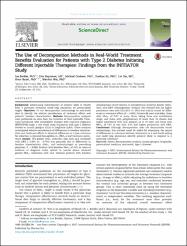Please use this identifier to cite or link to this item:
https://hdl.handle.net/20.500.11779/700Full metadata record
| DC Field | Value | Language |
|---|---|---|
| dc.contributor.author | Ke, Xuehua | - |
| dc.contributor.author | Buysman, Erin | - |
| dc.contributor.author | Wei, Wenhui | - |
| dc.contributor.author | Xie, Lin | - |
| dc.contributor.author | Grabner, Michael | - |
| dc.contributor.author | Brekke, Lee | - |
| dc.contributor.author | Başer, Onur | - |
| dc.date.accessioned | 2019-02-28T13:04:26Z | |
| dc.date.accessioned | 2019-02-28T11:08:19Z | |
| dc.date.available | 2019-02-28T13:04:26Z | |
| dc.date.available | 2019-02-28T11:08:19Z | |
| dc.date.issued | 2017 | - |
| dc.identifier.citation | Brekke, L., Buysman, E., Grabner, M., Ke, X., Xie, L., Baser, O., & Wei, W. (January 01, 2017). The Use of Decomposition Methods in Real-World Treatment Benefits Evaluation for Patients with Type 2 Diabetes Initiating Different Injectable Therapies: Findings from the INITIATOR Study. Value in Health : the Journal of the International Society for Pharmacoeconomics and Outcomes Research, 20, 10, 1252-1259. | en_US |
| dc.identifier.issn | 1098-3015 | - |
| dc.identifier.issn | 1524-4733 | - |
| dc.identifier.uri | http://dx.doi.org/10.1016/j.jval.2017.05.019 | - |
| dc.identifier.uri | https://hdl.handle.net/20.500.11779/700 | - |
| dc.description | Onur Başer (MEF Author) | en_US |
| dc.description.abstract | Background: Determining characteristics of patients likely to benefit from a particular treatment could help physicians set personalized targets. OBJECTIVES: To use decomposition methodology on real-world data to identify the relative contributions of treatment effects and patients' baseline characteristics. METHODS: Decomposition analyses were performed on data from the Initiation of New Injectable Treatment Introduced after Antidiabetic Therapy with Oral-only Regimens (INITIATOR) study, a real-world study of patients with type 2 diabetes started on insulin glargine (GLA) or liraglutide (LIRA). These analyses investigated relative contributions of differences in baseline characteristics and treatment effects to observed differences in 1-year outcomes for reduction in glycated hemoglobin A1c (HbA1c) and treatment persistence. RESULTS: The greater HbA1c reduction seen with GLA compared with LIRA (-1.39% vs. -0.74%) was primarily due to differences in baseline characteristics (HbA1c and endocrinologist as prescribing physician; P < 0.050). Patients with baseline HbA1c of 9.0% or more or evidence of diagnosis codes related to mental illness achieved greater HbA1c reductions with GLA, whereas patients with baseline polypharmacy (6-10 classes) or hypogylcemia achieved greater reductions with LIRA. Decomposition analyses also showed that the higher persistence seen with GLA (65% vs. 49%) was mainly caused by differences in treatment effects (P < 0.001). Patients 65 years and older, those with HbA1c of 9.0% or more, those taking three oral antidiabetes drugs, and those with polypharmacy of more than 10 classes had higher persistence with GLA; patients 18 to 39 years and those with HbA1c of 7.0% to less than 8.0% had higher persistence with LIRA. CONCLUSIONS: Although decomposition does not demonstrate causal relationships, this method could be useful for examining the source of differences in outcomes between treatments in a real-world setting and could help physicians identify patients likely to respond to a particular treatment. Copyright (C) 2017 International Society for Pharmacoeconomics and Outcomes Research (ISPOR). Published by Elsevier Inc. All rights reserved. | en_US |
| dc.language.iso | en | en_US |
| dc.relation.ispartof | Value In Health | en_US |
| dc.rights | info:eu-repo/semantics/openAccess | en_US |
| dc.subject | Real-world | en_US |
| dc.subject | Type 2 diabetes | en_US |
| dc.subject | Personalized medicine | en_US |
| dc.subject | Liraglutide | en_US |
| dc.subject | Insulin glargine | en_US |
| dc.subject | Choice | en_US |
| dc.subject | Decomposition analysis | en_US |
| dc.title | The Use of Decomposition Methods in Real-World Treatment Benefits Evaluation for Patients With Type 2 Diabetes Initiating Different Injectable Therapies: Findings From the Initiator Study | en_US |
| dc.type | Article | en_US |
| dc.identifier.doi | 10.1016/j.jval.2017.05.019 | - |
| dc.identifier.pmid | 29241884 | - |
| dc.identifier.scopus | 2-s2.0-85022207789 | - |
| dc.description.woscitationindex | Science Citation Index Expanded - Social Science Citation Index | en_US |
| dc.identifier.wosquality | Q1 | - |
| dc.description.WoSDocumentType | Article | - |
| dc.description.WoSInternationalCollaboration | Uluslararası işbirliği ile yapılan - EVET | en_US |
| dc.description.WoSPublishedMonth | Aralık | en_US |
| dc.description.WoSIndexDate | 2017 | en_US |
| dc.description.WoSYOKperiod | YÖK - 2017-18 | en_US |
| dc.identifier.scopusquality | Q1 | - |
| dc.relation.publicationcategory | Makale - Uluslararası Hakemli Dergi - Kurum Öğretim Elemanı | en_US |
| dc.identifier.endpage | 1259 | en_US |
| dc.identifier.startpage | 1252 | en_US |
| dc.identifier.issue | 10 | en_US |
| dc.identifier.volume | 20 | en_US |
| dc.department | İİSBF, Ekonomi Bölümü | en_US |
| dc.identifier.wos | WOS:000419245600004 | - |
| dc.institutionauthor | Başer, Onur | - |
| item.grantfulltext | open | - |
| item.languageiso639-1 | en | - |
| item.openairetype | Article | - |
| item.cerifentitytype | Publications | - |
| item.fulltext | With Fulltext | - |
| item.openairecristype | http://purl.org/coar/resource_type/c_18cf | - |
| crisitem.author.dept | 04. Faculty of Economics, Administrative and Social Sciences | - |
| Appears in Collections: | Ekonomi Bölümü Koleksiyonu PubMed İndeksli Yayınlar Koleksiyonu / PubMed Indexed Publications Collection Scopus İndeksli Yayınlar Koleksiyonu / Scopus Indexed Publications Collection WoS İndeksli Yayınlar Koleksiyonu / WoS Indexed Publications Collection | |
Files in This Item:
| File | Description | Size | Format | |
|---|---|---|---|---|
| WOS000419245600004_Acik.pdf | Yayıncı Sürümü - Makale | 649.14 kB | Adobe PDF |  View/Open |
CORE Recommender
Sorry the service is unavailable at the moment. Please try again later.
Items in GCRIS Repository are protected by copyright, with all rights reserved, unless otherwise indicated.